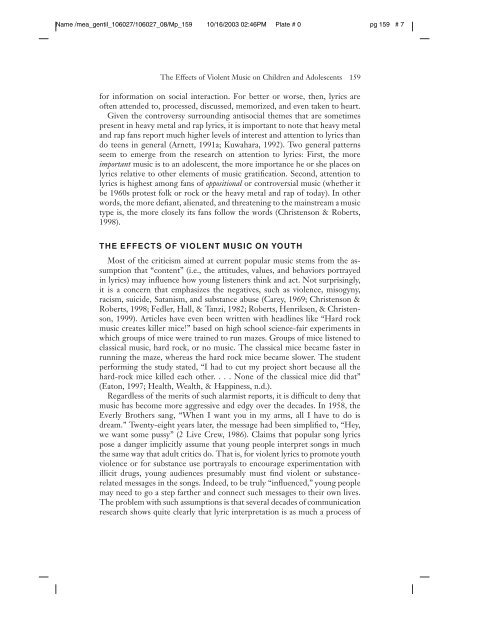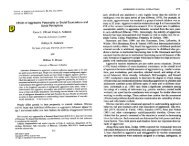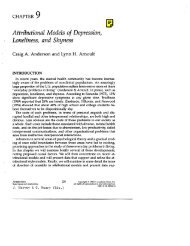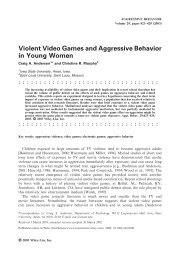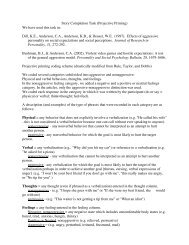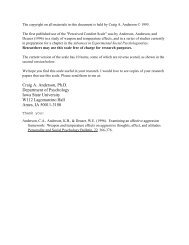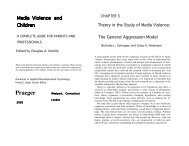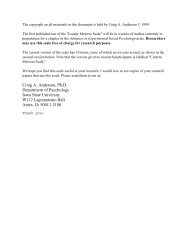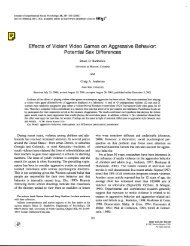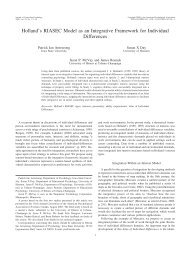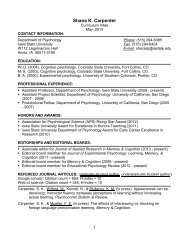The Effects of Violent Music on Children and Adolescents
The Effects of Violent Music on Children and Adolescents
The Effects of Violent Music on Children and Adolescents
You also want an ePaper? Increase the reach of your titles
YUMPU automatically turns print PDFs into web optimized ePapers that Google loves.
Name /mea_gentil_106027/106027_08/Mp_159 10/16/2003 02:46PM Plate # 0 pg 159 # 7<br />
<str<strong>on</strong>g>The</str<strong>on</strong>g> <str<strong>on</strong>g>Effects</str<strong>on</strong>g> <str<strong>on</strong>g>of</str<strong>on</strong>g> <str<strong>on</strong>g>Violent</str<strong>on</strong>g> <str<strong>on</strong>g>Music</str<strong>on</strong>g> <strong>on</strong> <strong>Children</strong> <strong>and</strong> <strong>Adolescents</strong> 159<br />
for informati<strong>on</strong> <strong>on</strong> social interacti<strong>on</strong>. For better or worse, then, lyrics are<br />
<str<strong>on</strong>g>of</str<strong>on</strong>g>ten attended to, processed, discussed, memorized, <strong>and</strong> even taken to heart.<br />
Given the c<strong>on</strong>troversy surrounding antisocial themes that are sometimes<br />
present in heavy metal <strong>and</strong> rap lyrics, it is important to note that heavy metal<br />
<strong>and</strong> rap fans report much higher levels <str<strong>on</strong>g>of</str<strong>on</strong>g> interest <strong>and</strong> attenti<strong>on</strong> to lyrics than<br />
do teens in general (Arnett, 1991a; Kuwahara, 1992). Two general patterns<br />
seem to emerge from the research <strong>on</strong> attenti<strong>on</strong> to lyrics: First, the more<br />
important music is to an adolescent, the more importance he or she places <strong>on</strong><br />
lyrics relative to other elements <str<strong>on</strong>g>of</str<strong>on</strong>g> music gratificati<strong>on</strong>. Sec<strong>on</strong>d, attenti<strong>on</strong> to<br />
lyrics is highest am<strong>on</strong>g fans <str<strong>on</strong>g>of</str<strong>on</strong>g> oppositi<strong>on</strong>al or c<strong>on</strong>troversial music (whether it<br />
be 1960s protest folk or rock or the heavy metal <strong>and</strong> rap <str<strong>on</strong>g>of</str<strong>on</strong>g> today). In other<br />
words, the more defiant, alienated, <strong>and</strong> threatening to the mainstream a music<br />
type is, the more closely its fans follow the words (Christens<strong>on</strong> & Roberts,<br />
1998).<br />
THE EFFECTS OF VIOLENT MUSIC ON YOUTH<br />
Most <str<strong>on</strong>g>of</str<strong>on</strong>g> the criticism aimed at current popular music stems from the assumpti<strong>on</strong><br />
that “c<strong>on</strong>tent” (i.e., the attitudes, values, <strong>and</strong> behaviors portrayed<br />
in lyrics) may influence how young listeners think <strong>and</strong> act. Not surprisingly,<br />
it is a c<strong>on</strong>cern that emphasizes the negatives, such as violence, misogyny,<br />
racism, suicide, Satanism, <strong>and</strong> substance abuse (Carey, 1969; Christens<strong>on</strong> &<br />
Roberts, 1998; Fedler, Hall, & Tanzi, 1982; Roberts, Henriksen, & Christens<strong>on</strong>,<br />
1999). Articles have even been written with headlines like “Hard rock<br />
music creates killer mice!” based <strong>on</strong> high school science-fair experiments in<br />
which groups <str<strong>on</strong>g>of</str<strong>on</strong>g> mice were trained to run mazes. Groups <str<strong>on</strong>g>of</str<strong>on</strong>g> mice listened to<br />
classical music, hard rock, or no music. <str<strong>on</strong>g>The</str<strong>on</strong>g> classical mice became faster in<br />
running the maze, whereas the hard rock mice became slower. <str<strong>on</strong>g>The</str<strong>on</strong>g> student<br />
performing the study stated, “I had to cut my project short because all the<br />
hard-rock mice killed each other. . . . N<strong>on</strong>e <str<strong>on</strong>g>of</str<strong>on</strong>g> the classical mice did that”<br />
(Eat<strong>on</strong>, 1997; Health, Wealth, & Happiness, n.d.).<br />
Regardless <str<strong>on</strong>g>of</str<strong>on</strong>g> the merits <str<strong>on</strong>g>of</str<strong>on</strong>g> such alarmist reports, it is difficult to deny that<br />
music has become more aggressive <strong>and</strong> edgy over the decades. In 1958, the<br />
Everly Brothers sang, “When I want you in my arms, all I have to do is<br />
dream.” Twenty-eight years later, the message had been simplified to, “Hey,<br />
we want some pussy” (2 Live Crew, 1986). Claims that popular s<strong>on</strong>g lyrics<br />
pose a danger implicitly assume that young people interpret s<strong>on</strong>gs in much<br />
the same way that adult critics do. That is, for violent lyrics to promote youth<br />
violence or for substance use portrayals to encourage experimentati<strong>on</strong> with<br />
illicit drugs, young audiences presumably must find violent or substancerelated<br />
messages in the s<strong>on</strong>gs. Indeed, to be truly “influenced,” young people<br />
may need to go a step farther <strong>and</strong> c<strong>on</strong>nect such messages to their own lives.<br />
<str<strong>on</strong>g>The</str<strong>on</strong>g> problem with such assumpti<strong>on</strong>s is that several decades <str<strong>on</strong>g>of</str<strong>on</strong>g> communicati<strong>on</strong><br />
research shows quite clearly that lyric interpretati<strong>on</strong> is as much a process <str<strong>on</strong>g>of</str<strong>on</strong>g>


